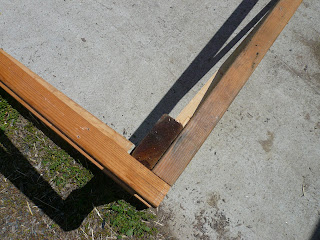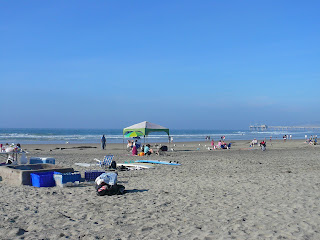Forgiveness & Salvation
“Grass is the forgiveness of nature -- her constant benediction. Fields trampled with battle, saturated with blood, torn with the ruts of cannon, grow green again with grass, and carnage is forgotten. Streets abandoned by traffic become grass-grown like rural lanes, and are obliterated. Forests decay, harvests perish, flowers vanish, but grass is immortal. Beleaguered by the sullen hosts of winter, it withdraws into the impregnable fortress of its subterranean vitality, and emerges upon the first solicitation of spring. Sown by the winds, by wandering birds, propagated by the subtle horticulture of the elements which are its ministers and servants, it softens the rude outline of the world. Its tenacious fibres hold the earth in its place, and prevent its soluble components from washing into the wasting sea. It invades the solitude of deserts, climbs the inaccessible slopes and forbidding pinnacles of mountains, modifies climates, and determines the history, character, and destiny of nations. Unobtrusive and patient, it has immortal vigor and aggression. Banished from the thoroughfare and the field, it bides its time to return, and when vigilance is relaxed, or the dynasty has perished, it silently resumes the throne from which it has been expelled, but which it never abdicates. It bears no blazonry or bloom to charm the senses with fragrance or splendor, but its homely hue is more enchanting than the lily or the rose. It yields no fruit in earth or air, and yet should its harvest fail for a single year, famine would depopulate the world.” [1]
Grasses, to too many of us, mean the sullen stubble that we esteem to adorn our living spaces. We even give it it's own name, a lawn, and it's vitality and care is an indicator of social success. Yet this is the lowest form of Nature's forgiveness. The beauty of grass is in the diversity of Nature's benevolence. For Nature does not dole out forgiveness equally. Nature's forgiveness can be as great as the cereals: wheat, millet, oats, rye, sorghum, barley, rice and maize. Or as limited as a lawn. We began with the forgiveness of Nature. Teff, spelt, einkorn, emmer, and durum are species of wheat that stood by us in the beginning. Buckwheat, quinoa, and amarynth are pseudo-cereals but grasses none the less. There are the grasses of the plains and grasslands that for centuries held fertility from the grasp of the winds across the open land of the midwest. The sedges and the rushes are found in the grasslands as well as the marshes. They filter water of it's impurities and make it fresh for all life. Papyrus, a rush, gave a bed for the written word to lay in. Bamboo is a grass. Nature's forgiveness feeds, clothes, and shelters us.
If grass is Nature's forgiveness then soil is our salvation. It is the soil from which Nature's forgiveness will sprout. And it is the soil that will pass judgement on us. It's very nature and structure will dictate if we are deserving of forgiveness. Nature has carefully been building it from the beginning. Mountains crumble slowly beneath the slow pressures of rain, wind, snow, and the sun. Freezing, thawing, expanding, contracting, cracking they turn all mountains to soil. Rivers cut through rock layer by layer. Glaciers moving at glacial speeds grind rock against rock to create sand, silt, and clay. These are the foundations of soil. Names given to indicate size and drainage.
Sand is the largest, followed by silt then clay. Pure sand drains water quickly. Watch the waves retreat off a beach. Does the water slip back into the ocean or does it disappear into the sand? Look even closer and see the dampness chase after the waves like a following shadow. Never holding water, without the waves it becomes a desert, loose and dry. Only special plants with roots that grow exceptionally deep or have leaves that can absorb moisture from the air can tolerate sand.
Clay is microscopic particles of soil that may as well be powder. Once wet those particles bind and create an impenetrable layer for water. Causing the land to shed needed rainwater, instead of soaking it up and recharging our dwindling ground water, which then causes many problems – flooding being one. When dried after being wet, clay creates a cement like surface from which there is no forgiveness. Dried clay is the archetypical cracked and blistered earth.
Silt is between sand and clay. That would lead one to believe that silt is the optimal building block for soil. But one would be wrong. Silt's size make it easy to be carried away by both water and wind. Clouding water supplies, which chokes fish, or clouding the air, which choke us. Silt is the most vulnerable. It cannot repel or accept the forces pitted against it.
The perfect soil is a mixture of the three. In nearly equal parts. It's called loam. It soaks up water and holds it as well as lets it drain. Plants need it both ways. They require the water for growth but not so much that their roots drown. The three are stronger together then apart. Yet this is only the inorganic material that Nature has used to create structure. Soil is also organic material.
A living thing will return to the soil from which it comes. Nature carefully takes apart the nucleotides and peptides she so precisely organized into DNA. The nutrients and building blocks from which new life is made. Humus is the dividing line. Beyond humus is the realm of inorganic. It is a line as fine and fragile as a spider's thread. Beyond humus no longer provides the nourishment that plants need. Humus is the work of community. Nature enlists the help of earthworms, dung beetles, sow bugs, millipedes, and many more. The slow process of breaking large into small is repeated many times. Each time a new member of the community steps in. The smaller parts are broken down by fungus and molds to even smaller parts. Finally those are broken down by billions of microbes. It is said that a teaspoon of soil contains more life than all the people on the planet. We share a kinship with soil when we try to comprehend the vastness of space.
The dust kicks up off the freshly tilled earth and with each gust of wind we lose our salvation. The soil must be covered. Either from decaying material in the form of a mulch or by Nature's forgiveness as a green mulch. This covering of the soil is it's skin. The protective layer that keeps moisture in and harmful heat and wind out. The forgiveness given by Nature will hold the soil in place through the toughest rain storm. It protects the soil in its entirety. For here is the secret. Soil is not just sand, silt and clay.
Our salvation lies in it all: sand, silt, clay, humus, earthworms, fungi, molds, sow bugs, microbes, and mulches. Without the clay there is no water retention and we have the barren space of a desert. Without the sand there is no drainage and we have floods in the rainy season and parched, cracked earth in drought. Without the humus there are no building blocks. Without the life in the soil there is no humus. Without a protective covering there is no moisture or life.
Soil is our salvation. Because our salvation lies in our ability to allow Nature to forgive us. But Nature's forgiveness is conditional. We may have the loam but no humus and Nature will forgive us enough to cover the soil. Nature will pass on the deficiency in nutrients to us. Externalizing her costs. It is only fair. We may even have the humus but we don't protect it. Nature will again forgive us but slowly, and at the cost of precious water. We can and have tried to bribe Nature into forgiving us through the use of chemical fertilizers. Each time Nature has turned the other cheek. Forgiving us though we surely are not deserving. At what point will she stop? Our salvation lies in the soil beneath our feet. All we need to do, is to finally ask for forgiveness.
[1] "In Praise of Blue Grass” by John James Ingalls (1833-1900), Senator from Kansas from 1873 to 1891. Excerpted from Grass - The Yearbook of Agriculture 1948. U. S. Government Printing Press. Washington 1948.

















